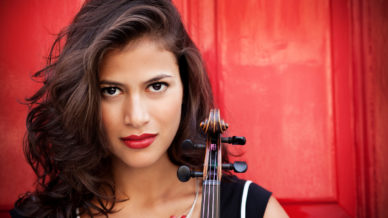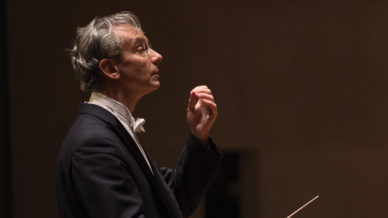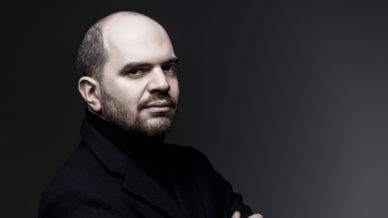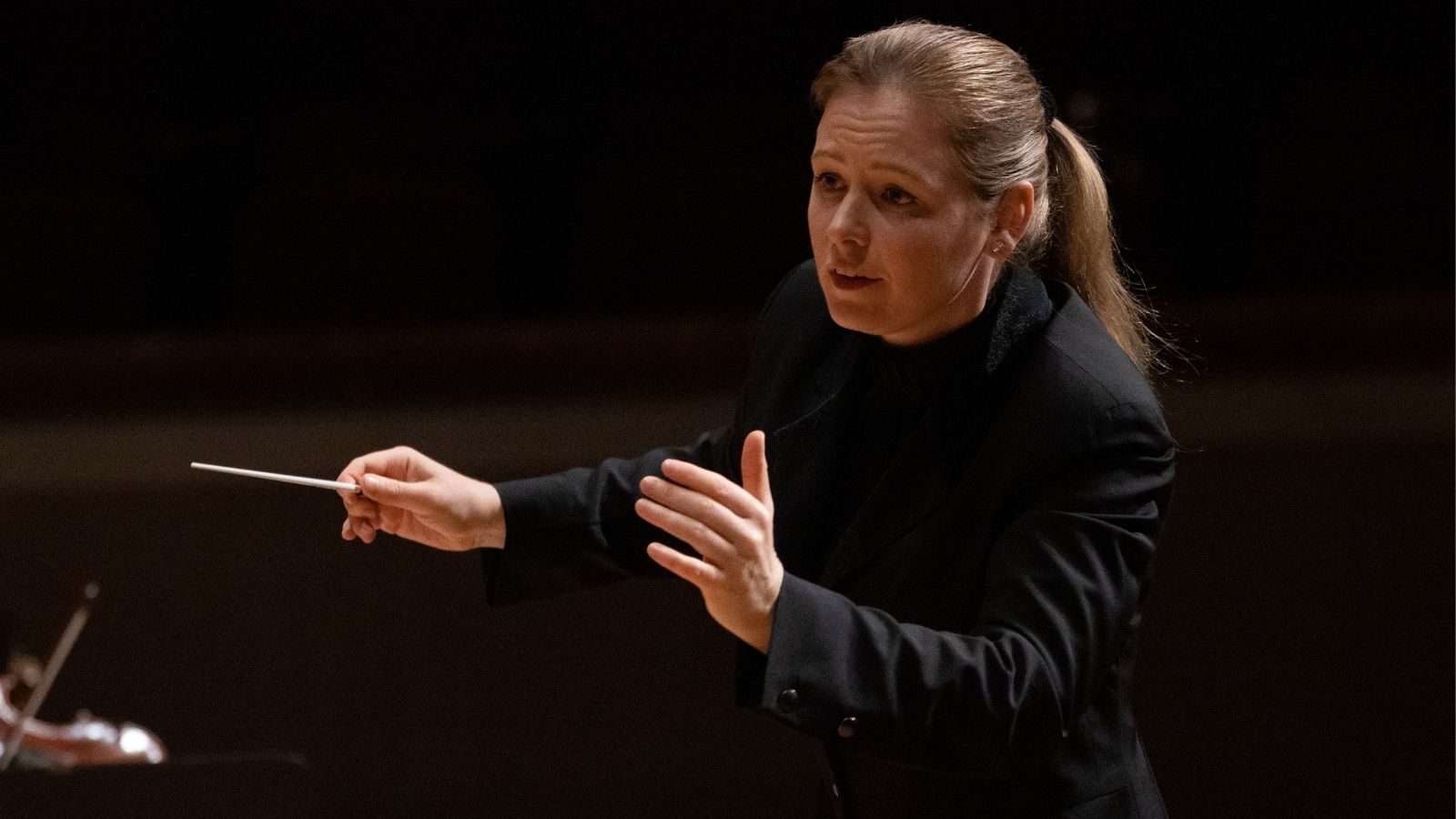

Mussorgsky’s Pictures
May 27 – 29, 2022
GEMMA NEW conducts
DONNACHA DENNEHY Memoria | US PREMIERE
RAVEL Rapsodie Espagnole
GRAINGER Pastoral, from In a Nutshell
MUSSORGSKY (ARR. RAVEL) Pictures at an Exhibition
Be one of the first to hear a new orchestral work by Donnacha Dennehy, a piece the composer says is “inspired by the way people (or our inventions of those people) live on vividly in our minds, even when they are no longer there in real life”.
Ravel’s colorful Rapsodie Espagnole is a magnificent musical homage to Spain and all its beautiful sights and sounds.
To end this enchanting program Principal Guest Conductor Gemma New takes you on a musical gallery tour in Mussorgsky’s most famous composition to view ten pictures on exhibit, from the eerie Parisian “Catacombs” to the tumultuous pealing bells of “The Great Gates of Kiev.”
Make a gift, and double the impact of your support! Thanks to a generous gift from our friends at the David M. Crowley Foundation, all new and increased gifts made by May 31, 2022 will be matched dollar-for-dollar, up to $75,000. Give Now

For information on our COVID-19 safety protocols, please visit here.
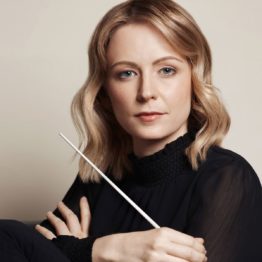
Program Notes
by René Spencer Saller
The Dublin-born composer Donnacha (DON-uh-kuh) Dennehy’s eclectic body of work includes large-scale orchestral pieces, three operas and a “docu-cantata,” electronic music, and compositions for solo instruments and chamber ensembles. His distinctive style reflects a wide range of influences, from minimalism to traditional Irish sean-nós (“old style”) singing. In 1997 he founded the Crash Ensemble, Ireland’s leading proponents of new and experimental music. He has fulfilled commissions from the Kronos Quartet, Dawn Upshaw, Augustin Hadelich, Alarm Will Sound, Bang on a Can, the Irish National Opera, the Saint Paul Chamber Orchestra, the Los Angeles Philharmonic, and Opera Theatre of St. Louis, among many others, and his music is performed in major venues and festivals throughout the world. Recordings of his compositions are available on the Nonesuch, NMC Recordings, Bedroom Community, and Cantaloupe Music labels.
Dennehy served as composer in residence for the Forth Worth Symphony Orchestra from 2013–14. Formerly a tenured lecturer at Trinity College Dublin, he joined the music faculty at Princeton University in 2014 and currently lives in the United States. In 2021 he received a Guggenheim Fellowship.
He wrote Memoria in 2021. Jessica Cottis led the RTE Symphony Orchestra in the world premiere, which took place on February 4, 2022, at the National Concert Hall in Dublin. This is its first performance in the United States.
The Composer Speaks
“Memoria is a piece inspired by the way people (or our inventions of those people) live on vividly in our minds, even when they are no longer there in real life. I’ve never felt this more strongly than in the last two years, when more than ever we have been made aware of the fragility, preciousness, and precariousness of life itself. This year, I lost two mentors who were of immense importance to me: Louis Andriessen and Hormoz Farhat. Memoria itself has a trajectory from the ethereal and elusive to the firmly present. It draws on some material from my opera The First Child that was based on a disguised melody. In Memoria, however, the disguised melody is gradually revealed, eventually appearing fully fledged in shuddering gasps. It is dedicated to the memory of Hormoz Farhat, my composition professor at Trinity in Dublin, and later my friend, someone who had a remarkable impact on the course of my life.” — Donnacha Dennehy
Rapsodie espagnole is so rich in the sounds of Spain that you’d never guess its French creator knew the country almost exclusively through his Basque mother. As the Spanish composer Manuel de Falla wrote, “How was I to account for the subtly genuine Spanishness of Ravel, knowing, because he had told me so, that the only link he had with my country was to have been born near the border!”
Although his family moved from the French Pyrenees to Paris when Ravel was still an infant, he retained a lifelong nostalgia for the music of Spain. Rapsodie espagnole, composed between 1907 and 1908, is among his first major works for orchestra. In his early 30s by that point, and a graduate of the Paris Conservatoire, he had already produced a string of impressive chamber works as well as the opulent orchestral song cycle Shéhérazade. (One of the movements in Rapsodie espagnole, a Habanero, is an orchestrated version of an 1895 work for two pianos, which he didn’t publish until 1907.) His meticulous attention to orchestration is evident throughout the four movements of Rapsodie espagnole, which incorporate Spanish-inflected castanets and tambourine, shadowy low winds, muted brass, and other beguiling instrumental colors.
A Closer Listen
The first movement, “Prelude to the Night,” is suffused with the silvery glow of an Iberian moonrise. A brief descending motif repeats hypnotically until clarinets and bassoons break in with concluding cadenzas. Named for a regional flamenco dance, “Malagueñas” is a lively, harmonically ambiguous miniature, with pizzicato double basses and strummed cellos standing in for the more traditional guitar. A surprisingly languid English horn solo closes the movement.
Ravel’s tempo indication for the next movement, the aforementioned “Habanero,” is “Rather slow, and with a weary rhythm.” Despite being named for a seductive Cuban dance, this “Habanero” is thought to be based on a song that Ravel’s mother taught him. On the manuscript for the two-piano version, the composer added a line from Baudelaire: “In the perfumed land that the sun caresses.”
The wistful English horn returns in the finale, which is otherwise lusty and festive, in keeping with its title, “Feria” (“Fair,” or “Festival”).
Born and brought up near Melbourne, Australia, Grainger was homeschooled by his mother, Rose Aldridge Grainger. Largely self-taught, Rose was intelligent and disciplined—and a strict disciplinarian. (Her harsh punishments may have sparked the composer’s later obsession with flagellation.) With an iron fist and a small team of tutors, she directed her only son’s education, imparting her love of music, visual art, and Nordic literature. In 1893 the 11-year-old boy wrote his earliest known original composition for piano: “A Birthday Gift for Mother.”
A piano prodigy, Grainger made his public debut in Melbourne when he was 12 years old. Starting at age 13, he attended the Hoch Conservatory in Frankfurt, Germany, for six years. The ever-loyal Rose followed him there, working as an English teacher to supplement the small stipend she received from her estranged husband, Percy’s father. After Grainger graduated, he and Rose lived in London, where the young man’s appealing looks, personal magnetism, and aggressive virtuosity brought him many wealthy and well-connected female admirers. He even met the Queen.
At the outbreak of the First World War, Grainger finally left Rose and relocated to the United States. He served as a musician in the U.S. Army from 1917 to 1919, becoming a U.S. citizen in 1918. He never returned to Australia.
In 1922 Rose killed herself, and Grainger, grief-stricken, spent several years traveling the world. After marrying in 1928, he settled in Westchester County, New York, where he taught, composed, lectured, and occasionally gave recitals. Legendary for his athletic technique and weird habits, Grainger liked to vault over his piano instead of simply walking around it. Among his many other eccentricities was his preference for arriving on foot to the towns and cities where he was scheduled to perform.
Poor health and cognitive decline marred his final years. In the end Grainger decided that he was a failure. He didn’t give up entirely, though: he gave his last concert in 1960, less than a year before his death at 78. Although he bequeathed his skeleton to the Grainger Museum, the curators opted to leave his remains in the family vault, alongside his mother’s ashes.
Pastoral, In a Nutshell
Structured in four movements, or sections, In a Nutshell takes about 20 minutes to perform. In 1916 Grainger conducted the premiere of the orchestral version, which took place at the Norfolk Festival of Music in Norfolk, Connecticut. The audience responded enthusiastically, undeterred by the suite’s uncompromising harmonic language, esoteric instrumentation, and bold jazz flourishes. Although Grainger also published arrangements for solo piano and piano, four hands, the original orchestral score was designated for orchestra, piano, and Deagan percussion instruments.
Thanks to his friendship and creative partnership with the Deagan family of Chicago, who designed and manufactured a line of mallet-played percussion instruments, Grainger had access to a trove of what he called “tuneful percussion.” For In a Nutshell, he deployed Grainger-designed, Deagan-built “Swiss Staff Bells,” which consisted of a rack of up to four octaves of Swiss handbells hung in a keyboard configuration and struck with mallets. The three other bespoke percussion instruments are the Deagan steel Marimba or Marimbaphone (or Hawkes’ Resonaphone); Deagan wooden Marimbaphone or Marimba-Xylophone; and Deagan Nabimba. Because of the rarity of these instruments today, most conductors substitute more widely available percussion instruments.
Pastoral is the third, and longest, movement of the suite. Grainger wrote one of the themes in 1907, in Surrey, England, and all the remaining music in 1915–16, while he was living in New York City; Ypsilanti, Michigan; and Rochester, New York.
Pastoral opens with a lyrical—indeed, pastoral—oboe solo, but soon enough the music darkens and gets denser, roughing up the impressionistic textures with astringent harmonies and unusual timbral combinations. Despite Grainger’s habit of writing lengthy program notes for each of his compositions, he apparently decided to let Pastoral speak for itself.
Mussorgsky subjected his scores to extensive revisions, and then, after his premature death, his friend Nikolay Rimsky-Korsakov saw fit to revise them even further. Both men were members of “The Five,” also known as “Mighty Handful,” an informal collective of likeminded composers who were active in St. Petersburg from the mid-1860s to the early 1880s. In 1922 Mussorgsky’s most famous work, Pictures at an Exhibition, got an additional Gallic makeover, courtesy of Maurice Ravel’s sumptuous orchestration.
An alcoholic who died at 42, Mussorgsky published very little: just a few songs and the vocal score to the opera Boris Godunov. If not for his colleague and former roommate Rimsky-Korsakov, who “corrected” his work before its posthumous publication, Mussorgsky might have faded into obscurity.
His most famous work, Pictures at an Exhibition, was probably never performed publicly during his lifetime. Maurice Ravel, whose orchestration is used for this performance, worked from Rimsky-Korsakov’s heavily revised version and never even saw the original score. It’s not quite a collaboration: collaborations imply consent, and both Mussorgsky and Rimsky had been dead for years by that point.
Mussorgsky composed the original piano suite in June 1874 as a tribute to a friend, the painter Victor Hartmann, who had died unexpectedly the previous year. Out of the hundreds of works he’d seen at a recent memorial exhibition, Mussorgsky focused on 10 canvases: fanciful watercolors, elaborate doodles, exotic vistas. He worked quickly and confidently. “Ideas, melodies come to me of their own accord,” he boasted in a letter. “I can hardly manage to put it all down on paper fast enough.”
Gallery Tour
To connect the movements inspired by each artwork, Mussorgsky used an introductory theme titled “Promenade.” In the composer’s words, the theme finds the viewer “roving through the exhibition—now leisurely, now briskly—in order to come close to a picture that has attracted his attention.” Initially voiced by trumpets, the promenade theme evolves throughout the suite, signaling subtle shifts of mood.
The cycle is rich in contrast and color. “Gnomus,” the first movement, is a hodgepodge of erratic leaps and uncanny harmonies. “The Old Castle,” based on two sketches of medieval French castles, features one of Ravel’s most brilliant innovations: an alto saxophone, which carries the Russian folk–infused main melody. (Although patented in 1846, the saxophone was still a novelty in 1922, when Ravel completed his orchestration.) “Tuileries,” light-glazed and lively, celebrates the charming mayhem of children romping in a formal French garden.
“Bydlo” plunges forward in an oxen-driven cart. The clucking, skittery “Ballet of Chicks in Their Shells” was inspired by Hartmann’s sketch of a young dancer in a canary costume clasping an eggshell shield. “Samuel Goldenberg and Schmuyle” unleashes stuttering sixteenth-notes from a muted trumpet. “Market at Limoges” depicts the chatter of Frenchwomen and the cheerful clamor of village life. In “Catacombs,” the promenade theme resurfaces, shadowy and dissonant. “The Hut on Fowl’s Legs” is a frenzied retelling of a famous Russian folk-tale. Finally, in “The Great Gate at Kiev,” the promenade theme finds its gleaming apotheosis, as Ravel’s ringing bells, crashing cymbals, and jubilant tam-tam propel the suite to its euphoric conclusion.
